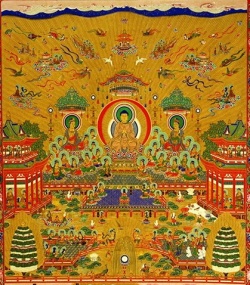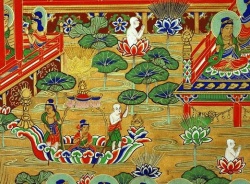Difference between revisions of "The Western Paradise"
| Line 1: | Line 1: | ||
[[File:Url32.jpg|thumb|250px|]] | [[File:Url32.jpg|thumb|250px|]] | ||
| + | |||
| + | |||
| + | |||
| + | |||
| + | |||
| + | |||
| + | |||
| + | |||
| + | |||
| + | |||
[[Mount Lushan]], in {{Wiki|southeast}} [[China]], is celebrated for the soft mists that blanket its sheer peaks and deep {{Wiki|forest}} valleys. This scenic area is also a [[World]] {{Wiki|cultural}} site. Since {{Wiki|ancient}} times many [[Spiritual]] and educational centers have been located there. Among these is the birthplace of [[Pure Land Buddhism]]. | [[Mount Lushan]], in {{Wiki|southeast}} [[China]], is celebrated for the soft mists that blanket its sheer peaks and deep {{Wiki|forest}} valleys. This scenic area is also a [[World]] {{Wiki|cultural}} site. Since {{Wiki|ancient}} times many [[Spiritual]] and educational centers have been located there. Among these is the birthplace of [[Pure Land Buddhism]]. | ||
| Line 6: | Line 16: | ||
The {{Wiki|Western}} [[Paradise]] | The {{Wiki|Western}} [[Paradise]] | ||
| − | [[Sukhavati]], the [[Pure land]] of the {{Wiki|West}}, is discussed in the [[Amitabha Sutra]], one of the three [[Sutras]] that are the [[principal]] texts of [[Pure land]]. It is the most important of the many blissful [[Wikipedia:Paradise|paradises]] into which [[Pure land]] [[Buddhists]] {{Wiki|hope}} to be [[reborn]]. | + | [[Sukhavati]], the [[Pure land]] of the {{Wiki|West}}, is discussed in the [[Amitabha Sutra]], one of the three [[Sutras]] that are the [[principal]] texts of [[Pure land]]. It is the most important of the many [[blissful]] [[Wikipedia:Paradise|paradises]] into which [[Pure land]] [[Buddhists]] {{Wiki|hope}} to be [[reborn]]. |
[[Buddhist]] [[scholars]] generally understand a [[Pure land]] as a [[transcendent]] [[state of being]]. In {{Wiki|Asian}} {{Wiki|folklore}}, on the other hand, a [[Pure land]] is [[Thought]] of as a {{Wiki|real}} place, not unlike the way many [[people]] conceptualize [[Heaven]]. The [[Pure land]] is not the final destination, however. | [[Buddhist]] [[scholars]] generally understand a [[Pure land]] as a [[transcendent]] [[state of being]]. In {{Wiki|Asian}} {{Wiki|folklore}}, on the other hand, a [[Pure land]] is [[Thought]] of as a {{Wiki|real}} place, not unlike the way many [[people]] conceptualize [[Heaven]]. The [[Pure land]] is not the final destination, however. | ||
| Line 15: | Line 25: | ||
[[Pure land]] [[Buddhists]] accept the basic [[Buddhist teachings]] of The [[Four Noble Truths]] and The [[Eightfold Path]]. The [[primary]] practice common to all schools of [[Pure land]] is the {{Wiki|recitation}} of the [[name]] of [[Amitabha]], who is also called [[Amida]]. | [[Pure land]] [[Buddhists]] accept the basic [[Buddhist teachings]] of The [[Four Noble Truths]] and The [[Eightfold Path]]. The [[primary]] practice common to all schools of [[Pure land]] is the {{Wiki|recitation}} of the [[name]] of [[Amitabha]], who is also called [[Amida]]. | ||
| − | In {{Wiki|Chinese}}, this [[chant]] is "[[Na-mu A-mi-to Fo]]" (Hail, [[Amida Buddha]]). The same [[chant]] in {{Wiki|Japanese}}, called the [[Nembutsu]], is "[[Namu]] [[Amida]] [[Butsu]]." Sincere and focused [[Chanting]] becomes a kind of [[Meditation]] that helps the [[Pure land]] [[Buddhist]] [[visualize]] [[Amitabha Buddha]]. In the most advanced stage of practice, the follower [[contemplates]] [[Amitabha]] as not separate from his own [[being]]. | + | In {{Wiki|Chinese}}, this [[chant]] is "[[Na-mu A-mi-to Fo]]" (Hail, [[Amida Buddha]]). The same [[chant]] in {{Wiki|Japanese}}, called the [[Nembutsu]], is "[[Namu]] [[Amida]] [[Butsu]]." Sincere and focused [[Chanting]] becomes a kind of [[Meditation]] that helps the [[Pure land]] [[Buddhist]] [[visualize]] [[Amitabha Buddha]]. In the most advanced stage of practice, the follower [[contemplates]] [[Amitabha]] as not separate from his [[own]] [[being]]. |
[[Pure land]] in [[Japan]] | [[Pure land]] in [[Japan]] | ||
| − | [[Pure land]] was founded in [[Japan]] by [[Honen]] [[Shonin]] (1133-1212), a [[Tendai]] [[Monk]] who had become discouraged by [[monastic]] practice. [[Honen]] emphasized the {{Wiki|recitation}} of the [[Nembutsu]] above all other practices, including [[visualization]], [[Rituals]], and even The [[Precepts]]. [[Honen's]] school was called [[Jodo-kyo]] or [[Jodo Shu]] (School of the [[Pure land]]). | + | [[Pure land]] was founded in [[Japan]] by [[Honen]] [[Shonin]] (1133-1212), a [[Tendai]] [[Monk]] who had become discouraged by [[monastic]] practice. [[Honen]] emphasized the {{Wiki|recitation}} of the [[Nembutsu]] above all other practices, [[including]] [[visualization]], [[Rituals]], and even The [[Precepts]]. [[Honen's]] school was called [[Jodo-kyo]] or [[Jodo Shu]] (School of the [[Pure land]]). |
[[File:Urlbn.jpg|thumb|250px|]] | [[File:Urlbn.jpg|thumb|250px|]] | ||
| − | [[Honen]] was said to have recited the [[Nembutsu]] 60,000 times a day. When not [[Chanting]], he {{Wiki|preached}} the [[virtues]] of the [[Nembutsu]] to laypeople and [[monastics]] alike, and he attracted a large following. | + | [[Honen]] was said to have recited the [[Nembutsu]] 60,000 times a day. When not [[Chanting]], he {{Wiki|preached}} the [[virtues]] of the [[Nembutsu]] to [[laypeople]] and [[monastics]] alike, and he attracted a large following. |
[[Honen's]] [[openness]] to followers from all walks of [[Life]] [[caused]] the [[displeasure]] of [[Japan]]'s ruling {{Wiki|elite}}, who had [[Honen]] exiled to a remote part of [[Japan]]. Many of [[Honen's]] followers were exiled or executed. [[Honen]] eventually was pardoned and allowed to return to {{Wiki|Kyoto}} just a year before his [[Death]]. | [[Honen's]] [[openness]] to followers from all walks of [[Life]] [[caused]] the [[displeasure]] of [[Japan]]'s ruling {{Wiki|elite}}, who had [[Honen]] exiled to a remote part of [[Japan]]. Many of [[Honen's]] followers were exiled or executed. [[Honen]] eventually was pardoned and allowed to return to {{Wiki|Kyoto}} just a year before his [[Death]]. | ||
[[Jodo Shu]] and [[Jodo Shinshu]] | [[Jodo Shu]] and [[Jodo Shinshu]] | ||
| − | After [[Honen's]] [[Death]], disputes over the proper [[doctrines]] and practices of [[Jodo Shu]] broke out among his followers, leading to several divergent factions. One faction was the [[Chinzei]], headed by [[Honen's]] [[Disciple]] [[Shokobo Bencho]] (1162-1238), also called [[Shoko]]. [[Shoko]] also stressed many recitations of the [[Nembutsu]] but believed the [[Nembutsu]] did not have to be one's only practice. [[Shokobo]] is considered to be the Second [[Patriarch]] of [[Jodo Shu]]. | + | After [[Honen's]] [[Death]], [[disputes]] over the proper [[doctrines]] and practices of [[Jodo Shu]] broke out among his followers, leading to several divergent factions. One faction was the [[Chinzei]], headed by [[Honen's]] [[Disciple]] [[Shokobo Bencho]] (1162-1238), also called [[Shoko]]. [[Shoko]] also stressed many [[recitations]] of the [[Nembutsu]] but believed the [[Nembutsu]] did not have to be one's only practice. [[Shokobo]] is considered to be the Second [[Patriarch]] of [[Jodo Shu]]. |
| − | Another [[Disciple]], [[Shinran]] [[Shonin]] (1173-1262), was a [[Monk]] who broke his [[vows]] of [[Celibacy]] to marry. [[Shinran]] stressed [[Faith]] in [[Amitabha]] over the number of times the [[Nembutsu]] must be recited. He also came to believe that [[devotion]] to [[Amitabha]] replaced any need for [[monasticism]]. He founded [[Jodo Shinshu]] ([[True School]] of the [[Pure land]]), which abolished [[Monasteries]] and authorized married {{Wiki|priests}}. [[Shodo Shinshu]] is also sometimes called [[Shin]] [[Buddhism]]. | + | Another [[Disciple]], [[Shinran]] [[Shonin]] (1173-1262), was a [[Monk]] who broke his [[vows]] of [[Celibacy]] to marry. [[Shinran]] stressed [[Faith]] in [[Amitabha]] over the number of times the [[Nembutsu]] must be recited. He also came to believe that [[devotion]] to [[Amitabha]] replaced any need for [[monasticism]]. He founded [[Jodo Shinshu]] ([[True School]] of the [[Pure land]]), which abolished [[Monasteries]] and authorized [[married]] {{Wiki|priests}}. [[Shodo Shinshu]] is also sometimes called [[Shin]] [[Buddhism]]. |
| − | Today, [[Pure land]]--including [[Jodo Shinshu]], [[Jodo Shu]], and some smaller sects--is the most popular [[Form]] of [[Buddhism]] in [[Japan]]. | + | Today, [[Pure land]]--[[including]] [[Jodo Shinshu]], [[Jodo Shu]], and some smaller sects--is the most popular [[Form]] of [[Buddhism]] in [[Japan]]. |
{{R}} | {{R}} | ||
[http://buddhism.about.com/od/purelandbuddhism/a/pureland.htm buddhism.about.com] | [http://buddhism.about.com/od/purelandbuddhism/a/pureland.htm buddhism.about.com] | ||
Latest revision as of 15:23, 14 January 2024
Mount Lushan, in southeast China, is celebrated for the soft mists that blanket its sheer peaks and deep forest valleys. This scenic area is also a World cultural site. Since ancient times many Spiritual and educational centers have been located there. Among these is the birthplace of Pure Land Buddhism.
In 402 CE the Monk and teacher Hui-yuan (336-416) gathered 123 followers in a Monastery he had built on the slopes of Mount Lushan. This group, called the White Lotus Society, vowed before an image of Amitabha Buddha that they would be reborn in the Western Paradise. In the centuries to follow, Pure Land Buddhism would spread throughout China. The Western Paradise
Sukhavati, the Pure land of the West, is discussed in the Amitabha Sutra, one of the three Sutras that are the principal texts of Pure land. It is the most important of the many blissful paradises into which Pure land Buddhists hope to be reborn.
Buddhist scholars generally understand a Pure land as a transcendent state of being. In Asian folklore, on the other hand, a Pure land is Thought of as a real place, not unlike the way many people conceptualize Heaven. The Pure land is not the final destination, however.
Hui-yuan and other early masters of Pure land believed that achieving the Liberation of Nirvana through a Life of monastic austerity was too difficult for most people. They rejected the "self effort" emphasized by earlier Schools of Buddhism. Instead, the ideal is Rebirth in a Pure land, where the toils and worries of ordinary Life do not interfere with devoted practice of The Buddha's teachings. By the grace of Amitabha's Compassion, those reborn in a Pure land find themselves only a short step from Nirvana. Practices of Pure land
Pure land Buddhists accept the basic Buddhist teachings of The Four Noble Truths and The Eightfold Path. The primary practice common to all schools of Pure land is the recitation of the name of Amitabha, who is also called Amida.
In Chinese, this chant is "Na-mu A-mi-to Fo" (Hail, Amida Buddha). The same chant in Japanese, called the Nembutsu, is "Namu Amida Butsu." Sincere and focused Chanting becomes a kind of Meditation that helps the Pure land Buddhist visualize Amitabha Buddha. In the most advanced stage of practice, the follower contemplates Amitabha as not separate from his own being. Pure land in Japan
Pure land was founded in Japan by Honen Shonin (1133-1212), a Tendai Monk who had become discouraged by monastic practice. Honen emphasized the recitation of the Nembutsu above all other practices, including visualization, Rituals, and even The Precepts. Honen's school was called Jodo-kyo or Jodo Shu (School of the Pure land).
Honen was said to have recited the Nembutsu 60,000 times a day. When not Chanting, he preached the virtues of the Nembutsu to laypeople and monastics alike, and he attracted a large following.
Honen's openness to followers from all walks of Life caused the displeasure of Japan's ruling elite, who had Honen exiled to a remote part of Japan. Many of Honen's followers were exiled or executed. Honen eventually was pardoned and allowed to return to Kyoto just a year before his Death. Jodo Shu and Jodo Shinshu
After Honen's Death, disputes over the proper doctrines and practices of Jodo Shu broke out among his followers, leading to several divergent factions. One faction was the Chinzei, headed by Honen's Disciple Shokobo Bencho (1162-1238), also called Shoko. Shoko also stressed many recitations of the Nembutsu but believed the Nembutsu did not have to be one's only practice. Shokobo is considered to be the Second Patriarch of Jodo Shu.
Another Disciple, Shinran Shonin (1173-1262), was a Monk who broke his vows of Celibacy to marry. Shinran stressed Faith in Amitabha over the number of times the Nembutsu must be recited. He also came to believe that devotion to Amitabha replaced any need for monasticism. He founded Jodo Shinshu (True School of the Pure land), which abolished Monasteries and authorized married priests. Shodo Shinshu is also sometimes called Shin Buddhism.
Today, Pure land--including Jodo Shinshu, Jodo Shu, and some smaller sects--is the most popular Form of Buddhism in Japan.

